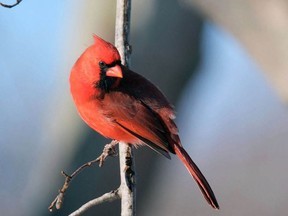
It’s time to flock together for the 27th annual Great Backyard Bird Count.
Advertisement 2
Article content
There’s no need to be an expert to participate. Organizers say you can just wing it.
Article content
“The Great Canadian Bird Count is great for beginners or experts,” said Kerrie Wilcox, a manager at Port Rowan-based Birds Canada. “Even if you just saw one bird – that’s great information. We want to know.”
The count, a joint project of the Cornell Lab of Ornithology, National Audubon Society and Birds Canada, creates a snapshot of where birds are around the world and helps scientists better understand global bird populations before their annual migrations, said Wilcox.
“Spending time in nature – even watching birds out your window – makes us feel happier and less stressed. Participating in the count helps birds and people.”
Watching your property for birds for as little as 15 minutes from Feb. 18 to 21 and sharing the data allows scientists to better understand our surroundings and use the information to help protect birds and the places they need to survive.
Advertisement 3
Article content
Participating with friends, family or a community group means there are more eyes to spot birds and a deeper well of knowledge to draw from, said David Bonter, co-director of the Center for Engagement in Science and Nature at the Cornell Lab.
“Knowing where birds are seen — and not seen — is more important than ever during this El Nino year, and as climate change weather fluctuations influence bird movements.”
More than 500,000 people participated in last year’s Great Backyard Bird Count. They reported more than 7,500 species of birds from more than 200 countries. In Canada, there were 33,050 checklists submitted and 255 bird species observed. In Norfolk, 168 checklists and 80 species were reported and, in Brant, 210 checklists and 72 species.
Advertisement 4
Article content
Birds have been in the news a lot over the past year, with some species spotted in unusual locations. Ornithologists speculate the birds may have been blown off course by increasingly fierce windstorms. The weather will also be influenced this year by the El Nino phenomenon.
“Strong El Nino conditions this year could bring surprises to the 2024 Great Backyard Bird Count,” said Patrick Nadeau, president and CEO of Birds Canada. “Temperatures are likely to be warmer, which could have an effect on the timing of spring migration and influence food availability.”
Wilcox said the real-time data collected through the count provides students, professional researchers and the public with access to years of reporting.
Advertisement 5
Article content
“We’re seeing how climate change weather fluctuations are impacting bird populations. Some species of birds are expanding their range north in winter with warmer winters. For example, we’re seeing more robins in Canada. It may be that more robins are migrating shorter distances or just staying during the winter.
“Northern cardinals have also expanded their range north since the Great Backyard Bird Count began. They may be benefitting from warmer winters, bird feeders, and the trend for homeowners to landscape their yards with shrubs that provide fruit for food and shelter in winter.”
To take part in the count, each participant or group counts birds for any length of time (but for at least 15 minutes) and enters the birds they could identify at each site they visited. That could be a backyard, a park, a wilderness area, an apartment balcony, even a landfill.
First-timers should read complete instructions at birdcount.org/participate where there are birding tips and bird app downloads. A free webinar about how to participate in the count will be held on Tuesday, Feb. 13 from 1 pm to 2 pm Register at bit.ly/47zPdlU .
Article content